Content
November 30, 2015 Flowers Alienteu
 With the arrival of autumn, it's time to think about what our gardens will be like in spring. Anyone who dreams of blooming spring flower beds should definitely plant bulbous plants in their area. Some of them can be planted only in spring, others also in summer. But many bulbous flowers are planted in the fall. And although they bloom, as a rule, in the spring, they are called autumn. When other flowers are still growing, and the trees are beginning to wake up, the autumn bulbs are already blooming. They will become the real pearl of your garden.
With the arrival of autumn, it's time to think about what our gardens will be like in spring. Anyone who dreams of blooming spring flower beds should definitely plant bulbous plants in their area. Some of them can be planted only in spring, others also in summer. But many bulbous flowers are planted in the fall. And although they bloom, as a rule, in the spring, they are called autumn. When other flowers are still growing, and the trees are beginning to wake up, the autumn bulbs are already blooming. They will become the real pearl of your garden.
Planting bulbous flowers before winter will ensure their early awakening. Now, when all their other bedding brothers shed their leaves and go into a state of sleep, these wonderful plants are already preparing to delight us with the first warm days.
Flowers that develop from bulbs are an ideal solution even for novice gardeners, because they are quite unpretentious to care for. The main requirement is a thorough selection of planting material and landing site.
Types of autumn bulbous
Consider first what kind of bulbous flowers are planted in the fall.
- Muscari (mouse hyacinth or viper bow) - perennial small plant (about 30 cm). The inflorescences resemble a bunch of grapes. Leaves come straight from the roots, flowers can be blue, purple, blue or white. It smells good of musk.
- Crocus (saffron) - a small plant, does not exceed 25 cm. It can be monochromatic: white, yellow, blue, purple, and also two-colored. The leaves are, as it were, collected in a bunch and they sprout simultaneously with the flower. The familiar saffron seasoning is made from the dried stigmas of this plant.
- Scylla (scrub) - a small plant. Has basal leaves. The flowers are shaped like stars and bells. They are located singly or collected in a brush on a flower arrow 10-15 cm. The color is most often blue and blue, less often it is pink, white and purple.
- Hyacinth - the basal rosette is formed from narrow, long leaves. Fleshy peduncle up to 30 cm. Bell flowers with petals slightly curved upwards. There are 35 or more flowers in the cluster inflorescence. It comes in a variety of colors, has a pleasant aroma.
- Narcissus - are one-color - yellow, white or sometimes pinkish, as well as two-color varieties are very beautiful. Has a pleasant tart aroma.
- Tulip - a plant from 10 to 80 cm tall. Large, long leaves. The flowers are very diverse in shape: goblet, cup-shaped, lily, sometimes with fringes along the edge of the petals, there are double varieties. Can be of any color, except blue tones.
- Imperial hazel grouse (fritillaria) - a plant with a strong stem. At the top of the peduncle is a tuft of green leaves, under them are inflorescences consisting of large drooping bell flowers (resembles a royal crown). The height of the flowering plant is 1-1.5 m. The bulbs have an unpleasant smell, but when the plant blooms, this smell becomes almost imperceptible.
Cooking the bulbs and soil 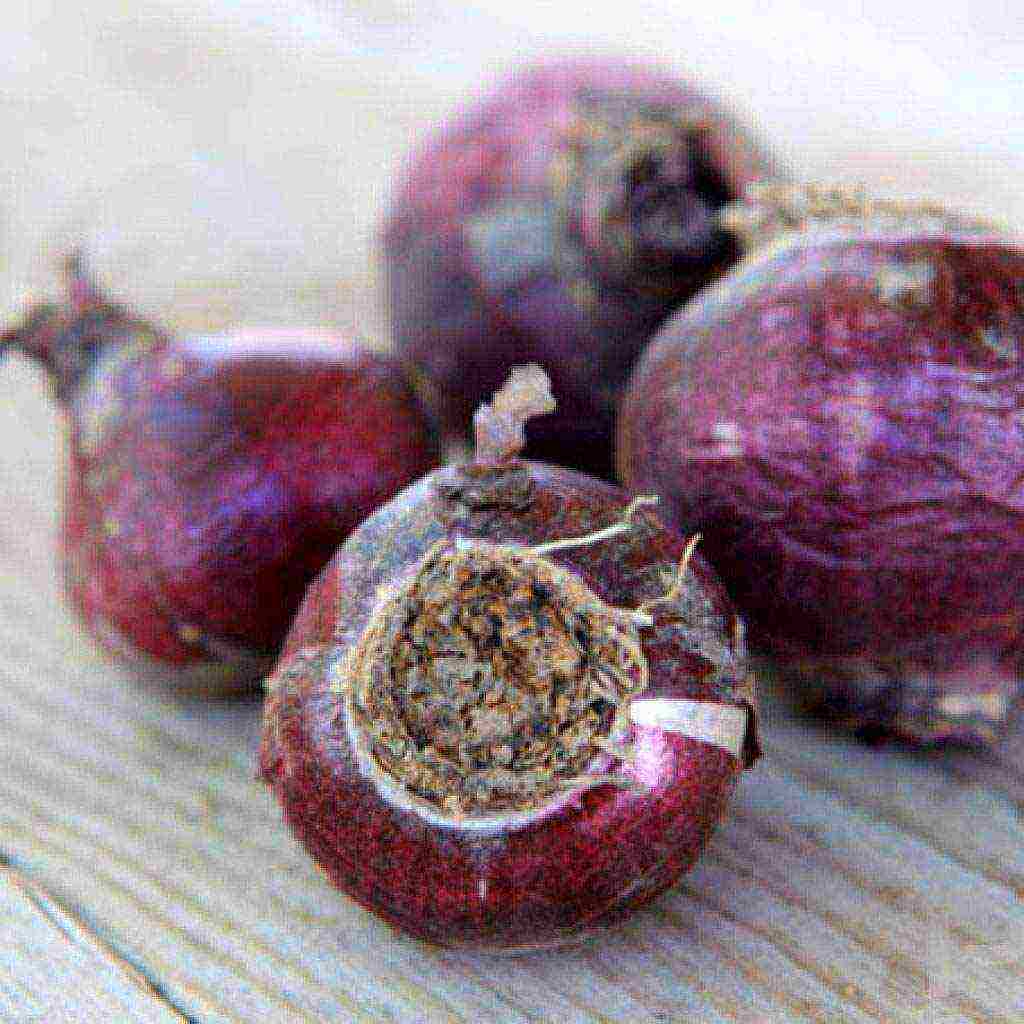
Hyacinth bulbs
We have decided on the types of flowers, now we will move on to preparing the bulbs for planting in the ground.
We carefully select the planting bulbs. Damaged, with specks, soft and darkened, we throw it away without regret.Only from relatively large, as well as even and necessarily hard bulbs will a strong and healthy plant grow. The bulb should not have a soft neck or bottom, overgrown roots, or a strongly sprouted stem. Good planting material is already half the battle. Immediately before planting, you can soak the bulbs for half an hour in the "Maxim" preparation for the prevention of rot.
Bulbous plants are planted in an area sufficiently lit and well protected from the wind. They love loose and permeable soil, therefore, in order to avoid bulb diseases, water stagnation must be excluded. Remove all weeds by the root. Dig up the area (about the size of a shovel bayonet). Apply fertilizer. It is better to use mineral fertilizers, compost or wood ash (manure cannot be used as fertilizer for bulbous plants). Fertilizer should be a little, since bulbous do not like an overabundance.
If the soil on the site is too dense or clayey, then it is better to drain sand about 5 cm (you can also use crushed stone or gravel). Bulbous flowers can be planted under tree branches, because when they bloom, there will be no leaves on the trees.
We plant correctly and on time
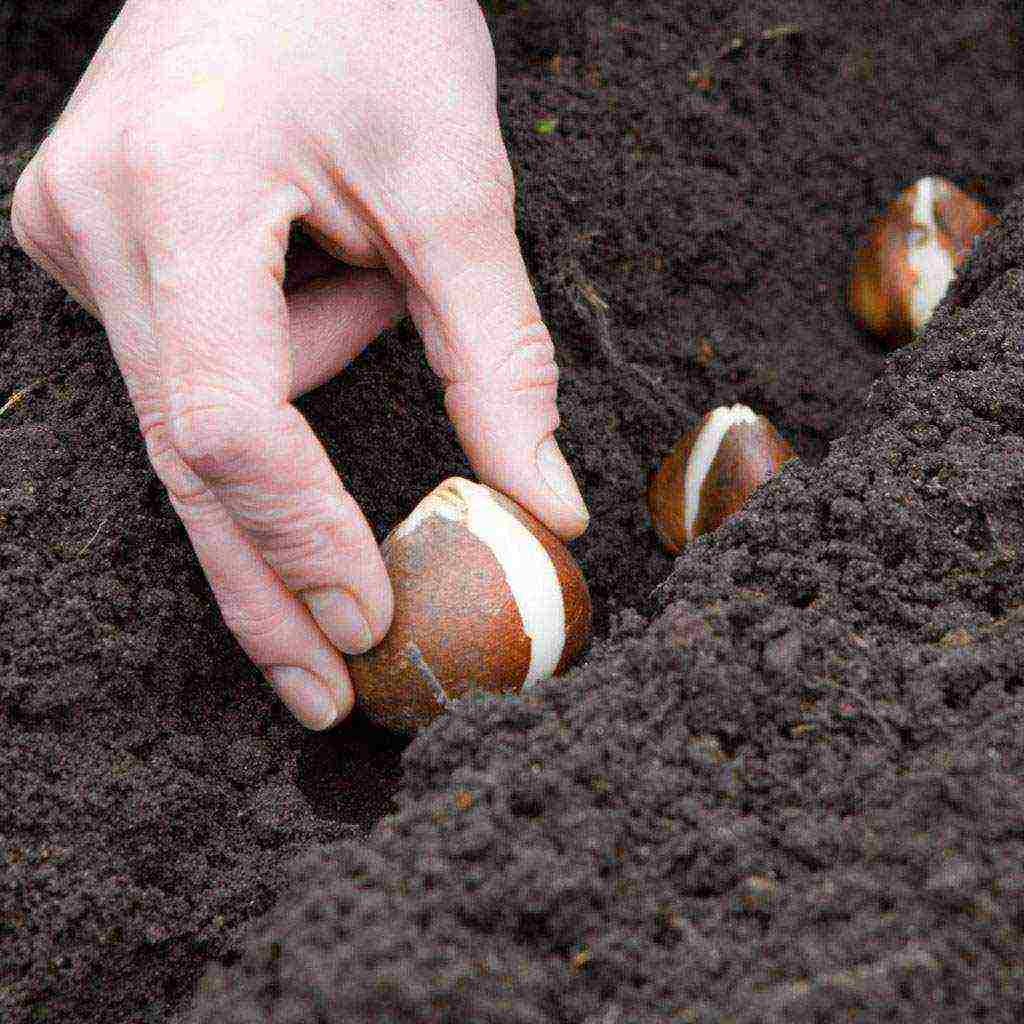
Planting bulbous flowers in the fall requires some knowledge and a little intuition. Plants planted too early can germinate and freeze. And too late - they will not have time to put down roots and disappear. Planting times depend on bulb size and climatic zone. You need to start planting when the soil temperature is 9-10 degrees, and finish 2-3 weeks before serious frosts with freezing of the soil. Small-bulbous plants take longer to root, so they are planted early.
 Let's draw up an approximate schedule for when it is better to plant various bulbous flowers:
Let's draw up an approximate schedule for when it is better to plant various bulbous flowers:
- hazel grouse - beginning of September;
- muscari, crocuses, scilla - mid-September;
- daffodils - end of September;
- hyacinths - early October;
- tulips - mid-October.
The planting depth, as well as the distance between them, directly depends on the type of plant, the size of the bulbs and soil. As a general rule, the depth should be 3 times the height of the bulb itself, and the width should be 4 times its diameter. When the soil is heavy, it is a couple of centimeters higher, and if it is light, it is deeper.
A deeply planted bulb will give few children, although it will increase in size. If it's small, it's the other way around. Densely planted flowers will grow weakened and more susceptible to disease. Put the bulb upside down in the planting hole and sprinkle with earth. Then, gently compact the soil lightly to avoid damaging the bulb. After planting, be sure to water it - this is necessary for normal rooting.
They can winter without shelter. You can mulch the bulbs with peat; other materials are also used for this (garden compost, decorative bark, wood chips). If the winter will be without snow and very frosty, then the planting sites can be covered with dry leaves, needles or straw.
You do not need to plant bulbous flowers in one place for 4-5 years, and you can not transplant within 3-5 years. Over time, the plant multiplies and several bulbs of different sizes appear in place of one, as a result of which they become small and gradually stop blooming.
In June, when the leaves of the bulbous plants have already dried up, the old roots die off, and the new ones do not grow yet. At this moment, you need to dig up the bulbs. A fine sunny day is best for this. They need to be thoroughly dried so that there is no moisture between the scales. Then clear from the earth, stems, leaves, separate the children. And store until autumn. To prevent the bulbs from freezing and drying out, the storage temperature is 10-15 degrees.
Disembarkation planning
Planting bulbous flowers in the fall gives the gardener a great opportunity to express their imagination and create the foundations of future flower arrangements. Then you will not need to think about decorating flower beds in spring.

In the shade of trees and shrubs, simple tulips and daffodils look spectacular in the garden. They will add brightness and fun to the monotonous areas of the garden.
One of the interesting options for planting bulbous flowers before winter is the creation of large flowering lawns, which by summer will be replaced by simple lawn grass. However, it must be borne in mind that bulbous plants cannot be mowed, they must wither naturally. For example, daffodils take about 8 weeks. Therefore, primroses are best suited for such lawns: crocuses, scilla, snowdrops. They fade quickly and free up space. Moreover, the combination of these flowers with the first grass will give the effect of an alpine meadow.
In a classic garden with strict lines, monoclbeds and tulip mixborders will be appropriate. They will well emphasize the brevity of the style.
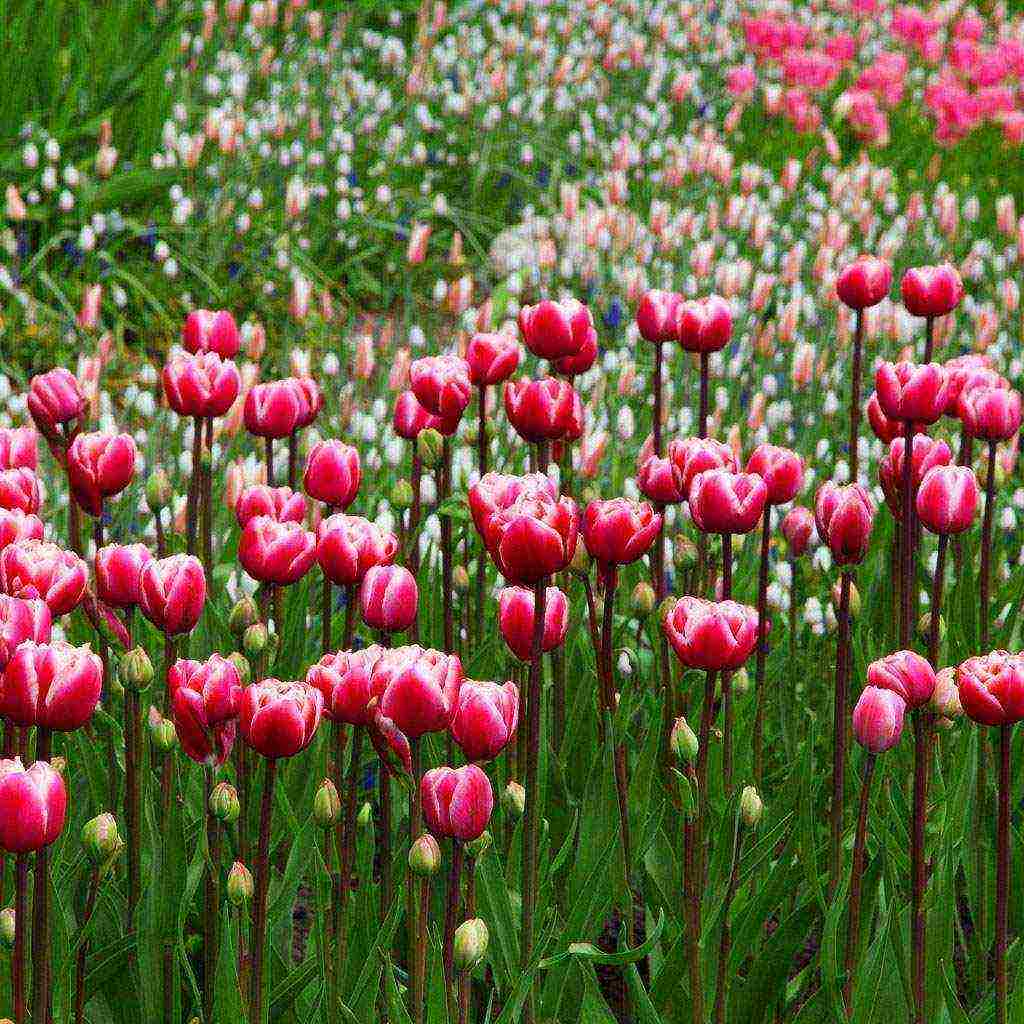 Crocuses and woodlands will look very harmonious on an alpine slide or in a rockery. Alpine slide can be decorated with high-stemmed tulips and various flower shapes.
Crocuses and woodlands will look very harmonious on an alpine slide or in a rockery. Alpine slide can be decorated with high-stemmed tulips and various flower shapes.
Make some color accent too. By planting, for example, daffodils next to hazel grouse. Or play with the contrast of daffodils and deep blue muscari.
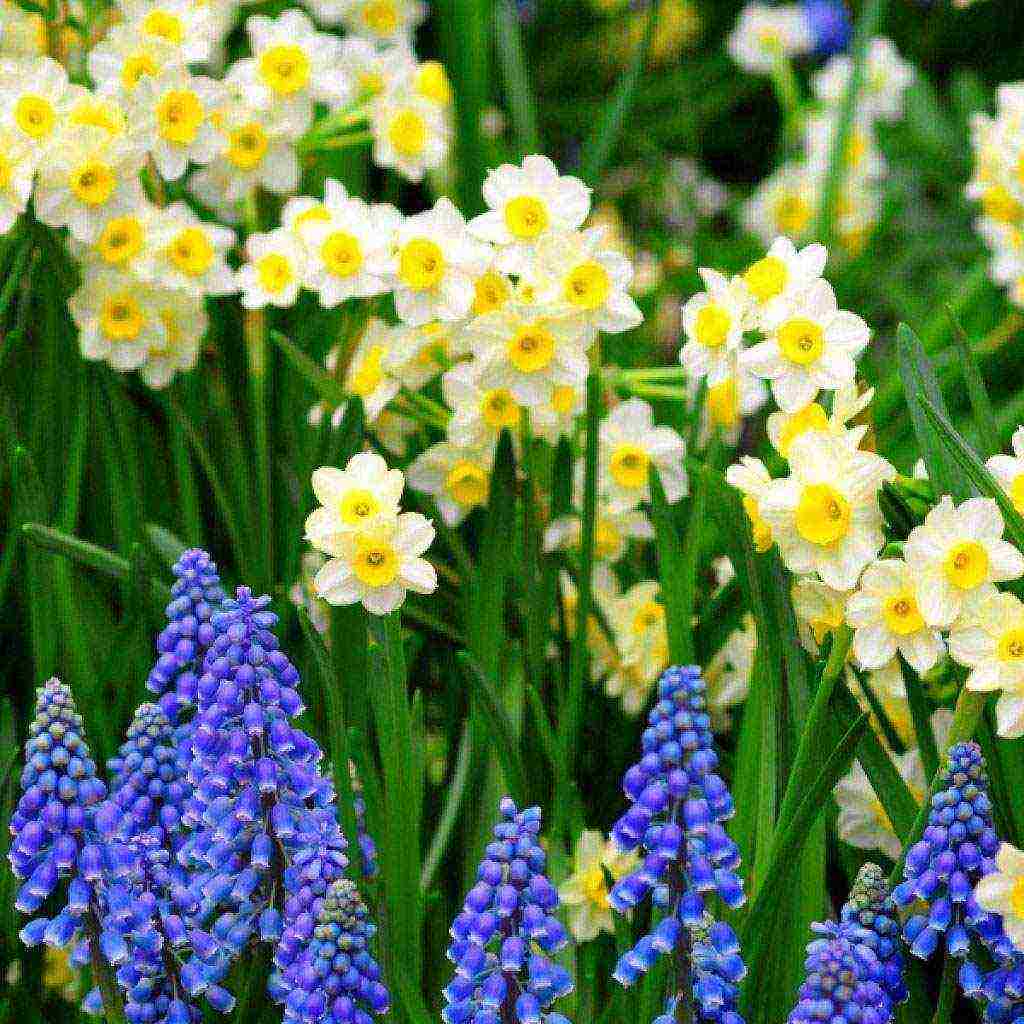
You can create flower beds from only one bulbous flower. Plant them tightly in the center and a little less often at the edges. Or, tall bulbous flowers can be planted in the center, and the edges can be decorated with undersized ones.
If you plant first bulbous flowers in groups of 5-10 pcs., Then between them you can plant forget-me-nots, daisies, pansies. You will get a beautiful mixed composition.
A few important tips
... It may happen that for some reason the autumn planting dates were missed, then tulips can be planted until December. Only the ground should not be frozen (so that the shovel freely enters the ground) and after planting it is imperative to cover the flower bed with straw, spruce branches, and dry leaves.
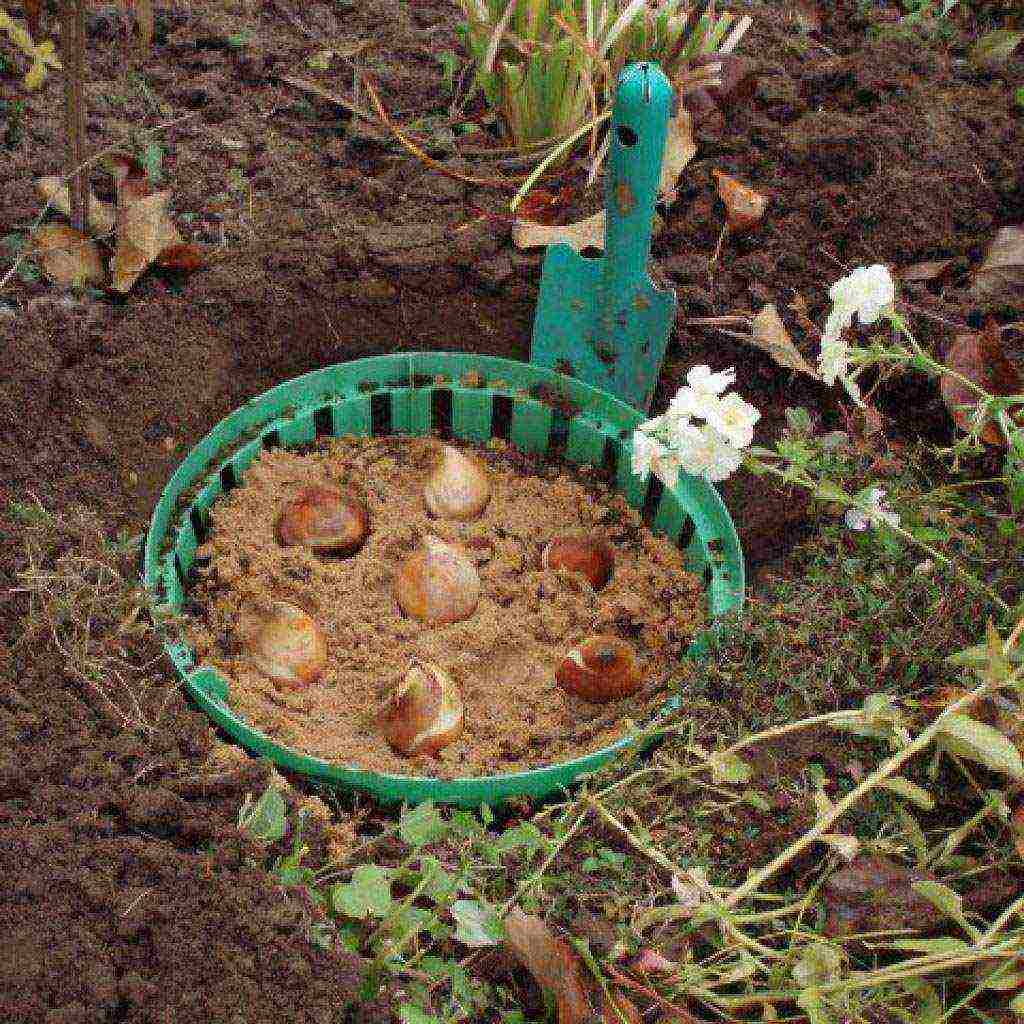
2. To combat mice and other rodents that eat bulbs, planting is carried out in special baskets. You can also treat the bulbs with a repellent or try using hot pepper infusion or tobacco juice for a one-time watering of the soil.
... Scylla can be planted on a green lawn by cutting and peeling back a small layer of sod with grass. Then loosen the soil a little and put the bulbs. Now we put the lawn layer back in place and lightly tamp it. Be sure to water well. The grass on the lawn will not be damaged, and in the spring, beautiful little flowers will appear among it.

Most of the bulbous flowers are planted in the fall, and when they are among the first to appear in the spring, they inform us that winter is over. And although there is often snow in some places, green pets fill the garden with bright warm colors, give us a joyful spring mood, awaken hope for a miracle in our souls.
Bulbous flower varieties form a separate group of plants that are cultivated and cared for in a special way. Therefore, the planting of bulbous flowers in the fall should be carried out using a special technology in order to get strong and lush plants next year.
What bulbous to plant
In order for planting bulbous varieties of flowers before winter to be successful, it is necessary to understand which varieties (multi-tiered, etc.) and when should be planted in open ground. The fact is that different varieties differ from each other not only in the characteristics of the buds, but also in the timing of planting. If the bulb is planted too early in the fall, it will begin to sprout and freeze when the cold weather sets in. With a late planting, the plant will not have time to take root and will die. It is no longer possible to save him.
You need to know that the time to complete this procedure depends not only on varietal characteristics, but also on factors such as the size of the planting material and weather conditions. Experienced growers note that planting should be started when the ground temperature has dropped to 9-10 ° C.The procedure should be completed approximately 2-3 weeks before frost begins and the soil freezes.
Video "Planting bulbous flowers in the fall"
In this video, an expert will talk about planting flowers such as lilies, hyacinths, tulips and crocuses in the fall.
Let's take a closer look at which bulbous flowers you need to plant in the fall.
In September
In early September, it is necessary to plant species such as rudbeckia, solidago, phlox and astilde. This is a great time to dig up the bulbs and store them. It is worth noting that the excavation must be carried out correctly in order to prevent damage to the workpieces. The bulbs should be treated before storage to protect them from rot and disease. During storage, the plants must also be protected from rodents.
In the first decade of the month, flowers are also transplanted to a new location. Bulbous varieties should be transplanted periodically (every 4-5 years) so that they do not disappear. In the process of transplanting, you can propagate plants by dividing the bush.
In early autumn, small-bulbous species (for example, Pushkinia, Scylla, Chionodox, Muscari and Crocuses) should be planted in the soil. In the second half of the month, plant daffodils in the ground, and a week later - hyacinths. In the last decade of September, you should start planting tulips.
In October
In October, until the middle of the month, hyacinths and tulips are planted. Some say that hyacinths need to be planted at the beginning of the month, and tulips in the middle. It should be noted that in this case, the plants will better cope with the pathogenic microflora.
In November
This month you can plant tulips in open ground, but only if there is one condition - the year must be warm. At the same time, the temperature this month should not fall below +5 ° C. Otherwise, the bulbs will slow down in growth or even die.
At this time, the corm flower can be planted at home. If you take care of it correctly, then in the spring you can plant a rather tall and strong plant in open ground. Remember that tulip care during the winter must be optimal so that they begin to bloom on time.
At home, flowers are usually distilled for the winter and spring holidays. You can also store the bulbs in the refrigerator and plant them in the ground in the spring.
Now it is clear when to plant bulbous varieties of flowers in the fall.
Landing features
Fall bulbous flowers must be planted using a specific technology. But in order for the plants to take root in a new place, you need to choose the right site and prepare the land. If everything is done right, then in the spring the first shoots in the flowerbed will appear just in time.
Site selection and soil preparation
The choice of a site for growing bulbous plants is a very important stage. The quality of its implementation directly depends on how quickly new residents of the flower bed can germinate after winter. A well-lit place is chosen. Cold air masses should not pass through it. Moisture should also not accumulate on the site or groundwater should come close to the surface.
In order for such flowers to grow in autumn, the soil in which they were planted must be nutritious. A neutral or slightly acidic environment is desirable. Therefore, the land is prepared in advance. Preparation is carried out 2 months before the estimated time of disembarkation. Fertilizer (compost) should be added to the soil, which will correct the acidity of the soil. Also, moisture-retaining and loosening components can be added to the ground.
Landing technology
Bulbs must be protected from pathogenic microflora that lives in the ground. For this, they are treated with special agents (fungicides) or a weak solution of potassium permanganate. When the plants are ready, we can start planting them. Bulbous flowers are planted using the following technology:
- first you need to water the place so that the dry soil is soaked.It is necessary to water the ground only when it is dry;
- it is not recommended to loosen the soil, since otherwise, during precipitation, the roots will rise and the flower will turn out to be small and weak;
- then the depth at which the bulb is planted is determined. This parameter depends on the plant variety. As a general rule, the depth is equal to a third of the height of the bulb. In this case, the width of the hole should be 4 times the diameter. In the case of heavy soils, the depth decreases by several centimeters, and in light soils, it increases;
- then a furrow is made with a hoe. Bulbs are planted in it at regular intervals (the distance depends on the type of flower). Then the planting material is covered with earth and in this form it remains to winter.
In some regions with a harsh climate, beds with such plants are covered with material for the winter in order to protect the plantings from freezing. In the spring, when the snow melted, the bed opens up.
Knowing the technology described above, planting bulbs in the Moscow region or in any other region will take place without problems.
Autumn is a hot season for flower growers. It's time to sigh sadly, remembering the past summer, and roll up your sleeves - there is still a lot of work before winter! One of the most important is the autumn planting of bulbous plants. Do not flatter yourself, believing that all you need is to loosen the earth and stick an onion into it. This is done by flower growers who do not take into account the needs of plants, but we are not like that?
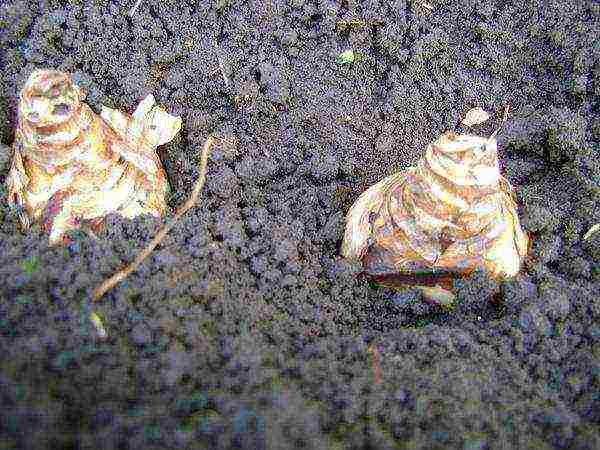
Having decided to tell everything I know about the autumn planting of bulbs, I ran into a problem. Our club has brought together plant lovers from different regions - how to give universal recommendations for the inhabitants of the Urals and the Caucasus in one article? Sincerely wishing that the material would be useful to everyone, I decided to highlight
the most important principles of autumn planting bulbous. These are universal rules, knowing which, you can easily navigate the timing of planting, determine the need
shelter for the winter
and other subtleties relevant to your region.
Landing time
On average, a bulb takes root in non-frozen ground in 2 weeks. This is where we should proceed. Surely you already know when it's time for stable frosts. Of course, Mother Nature can sometimes present unpleasant surprises - a thaw after persistent frosts or a sharp onset of winter after a long warm autumn. Don't panic, we have everything under control!
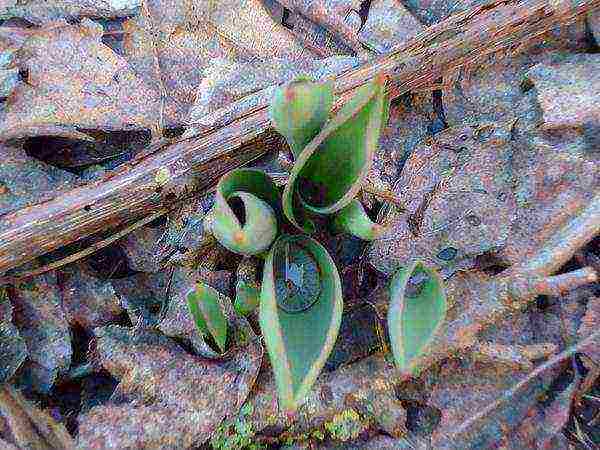
If your bulbs managed to sprout, and then suddenly winter came, they just need to cover... Lapwood, hay, straw, fallen leaves - whatever is at hand will do. This does not apply to the sprouts of daffodils and tulips - they winter wonderfully under the snow.
Another variant: frost has come, and you have not yet planted bulbous... No matter how wild it sounds, you can still plant them: there are several thaws ahead, during which the earth will warm up enough for the bulbs to take root. This can be done if the soil is not frozen to the planting depth. This is the way for those looking for early spring bloom.
If the timing of flowering is not important, plant the bulbs in the spring, they will overwinter excellently outside the soil. The value of the autumn planting of bulbs is that it allows you to get the earliest flowering. By the way, if in the fall plant the bulbs at intervals of 5-7 days, then in the spring you can get a flower bed that blooms continuously for a month, or even longer! Try it - the result will pleasantly surprise you. Moreover, you can use bulbs of the same type and variety - the planting time will delimit the time of their flowering.
Bulb planting site
Again, I will give the basic principles, and you really adapt to them. What do you need to protect bulbs wintering in the open field? From frost, contact with groundwater and from excess dryness of the soil... What does it mean? This means that the bulbs must spend the winter in soil that is moist below their planting level and dry above them. Hard? Far from it!
If you planted the bulbs in a place with high groundwater levels, make sure that precipitation cannot penetrate your plantings for the winter period. That is, cover this area with a film, shield, profile sheet - whatever you can. This method is called dry wintering.
Keep in mind that bulbs that have been growing in a permanent place for more than one year winter better. Therefore, you should not dig up tulips, crocuses, daffodils and other bulbs every year. They are can grow without replanting for 3-4 years, this period will not at all affect the size of the plant, the duration and decorativeness of flowering.
Soil composition
Very important, be sure to read! Bulbous plants start growing in the fall, so it is very important that this start is successful. What is needed for this? Nutritious soil. It will have to be prepared in advance. You know that planting bulbs in the same place is not recommended? Of course - after all, pathogens could remain in the soil, and even bulbs treated with fungicides are at risk. In order not to expose the plants to the danger of infection and to preserve their own planting material, it is better to plant them in a new place.

It should be sunny, inaccessible to strong winds, with a low level of groundwater, with fertile permeable soil. Remember the acidity level! Bulbous love slightly acidic or neutral soils... Experts advise to prepare a place for planting bulbs in advance, 2 months in advance. Composting, adjusting acidity, adding soil loosening and moisture-retaining components - do not neglect anything! Do you want to get large plants with a full set of varietal characteristics?
Planting bulbs
So we got to the most important thing - landing. It is well known that planting depth you need to choose this way: in loose soil - 3 heights, in dense soil - 2 heights of the size of the bulbs. As a practitioner, I can advise my planting method.
I never loosen the soil in which I plant bulbs. So I prepared it 2 months ago, during this time it rained, it thickened a little, but it doesn't matter. I make grooves with a hoe and plant bulbs in them. My principle is that the bottom of the onion should run into a dense layer of soil... Why? I'll explain now.
I used to think that it would be easier for the roots of the bulbs to grow into loose soil, so I dug up the flower beds for planting to the depth of a shovel. How wrong I was! Look: the bulb has been planted and is taking root. It is very important not to disturb them! What happens in the case of dug up soil? The bulb has taken root, the soil is saturated with precipitation and gradually settles, the roots rise upward. What will we get as a result? Weakened plant with late development and flowering. I am already silent about its size. In general, take into account my sad experience and plant the bulbs in un-dug soil, you will not regret it.
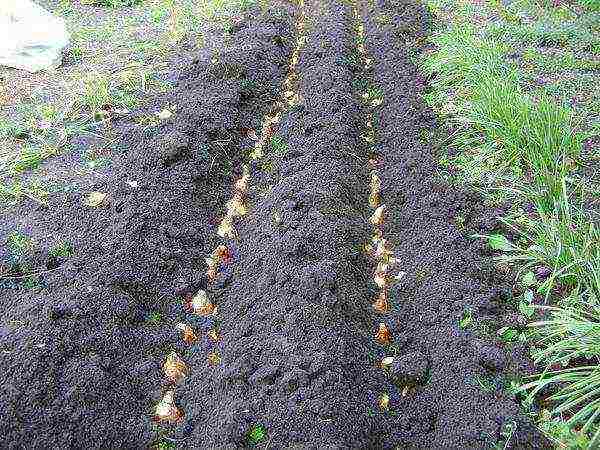
Do the bulbs need to be processed before planting? I always use a fungicide, especially for newly purchased planting material. Another important condition for success is watering after planting, it is needed if the ground was dry.
I tried to mention the most important principles and rules for planting bulbs in autumn. But, if you still have questions, ask! Maybe share your experience? It would be great, because there is never too much of it)
What a spring without tulips and hyacinths, daffodils and crocuses! But we need to take care of a flower bed with bulbs in the fall, so that the plants will delight us with early flowering.
Dates of planting bulbous flowers in the fall.
Unfortunately, there is no single term for all regions. Too different weather conditions in the north of the country and in the south. Therefore, we have collected general recommendations, being guided by which, you can decide on the timing of planting yourself.

On average, a bulb takes two weeks to take root.... From here, count down the time when it will be necessary to place them in the ground. But the weather has its own rules.Sometimes unexpected frosts take us by surprise, and sometimes thaws come in the midst of a fierce winter. But this should not scare us, because we cannot foresee such surprises, but we must prepare for them.
Do not despair if sprouts have already appeared on your flower bed, and frost has unexpectedly hit. Young leaves must be covered. Any material that you have at hand will do: spruce branches, straw, fallen leaves, and so on.
Moreover, the sprouts of tulips and daffodils can winter well under the snow. Therefore, it is worth worrying only if the frosts have already come, and the ground has not yet been covered with snow.
If frost has begun, and you have not had time to plant flowers. Don't worry, the first frost is always followed by a thaw, and there will be enough for your plants to take root. You can start planting if the ground has not yet frozen to the depth necessary for the growth of the plant.
Choosing a landing site.
What should be protected from bulbous in order to get strong plants with large flowers?
From frost, groundwater and dry soil. That is, the ideal conditions look like this: groundwater moistens the soil under the bulb, but does not affect it itself, the soil above the bulb remains dry, and there is also protection from frost.
It seems incredibly difficult. Don't be alarmed. If the water table is too high in your area in the spring, then make sure that as little moisture as possible penetrates the bulbs during the winter. Just cover them with something that is waterproof, such as a film, or a shield, or a piece of roofing material.
Thus, you will arrange a "dry winter" for your flowers.
In nature, bulbs grow in open spaces. Therefore, it is best to choose a place in the garden for them that is sufficiently sunny. But keep in mind that in the brightest sunshine, your plants will fade much faster than if they are covered with a light shade on the floor.
A place where the sun appears only for half a day is also suitable. Keep in mind that high humidity in the area of the roots leads to their rotting, and a strong draft will ruffle the buds and steal some of the decorativeness of your flower bed.
Preparing the soil for planting.
You should not constantly plant bulbs in the same place. Crop rotation principles work for flowers as well. Planting each year increases the number of parasites and diseases in the soil that are specific to that particular plant. Bulbous plants do not grow in acidic soil.
The most suitable acidity for them is neutral. It is worth taking care of the landing site in advance. The fact is that these plants love loose soil around the bulb, but it is desirable that the bottom lie on dense soil.
Imagine that the bulbs have already given roots, and the loose soil has settled after watering or rainfall. The roots are damaged and the plant is stressed. To avoid this, the soil is prepared in advance. Compost is added, if necessary, to reduce acidity, sand is added to make it friable.
In a couple of weeks, the soil will have time to compact and settle. This means that the roots will grow without stress.
We plant the bulbs in the ground.
Planting depth should correspond to: in loose soil - the height of three bulbs, and in dense soil - to the height of two bulbs.
Before planting, it will not be superfluous to treat the bulbs with a fungicide or potassium permanganate.
If the weather is rainy, then additional watering is not required.
In dry weather, watering is essential for rooting.
Those bulbs that did not have time to give the roots will perish in frosts.
IMPORTANT! Do not repot or dig up the bulbs every year. Best of all, those who have lived in one place for three or four years winter and bloom later.
By the way, the first flowers are so pleasing to our eyes! But their flowering is too short-lived. If you plant bulbs in the fall with an interval of five to seven days, then in the spring your flower bed can bloom continuously for a month.
After all, the earlier you planted the bulb in the fall, the earlier it will bloom in the spring.


